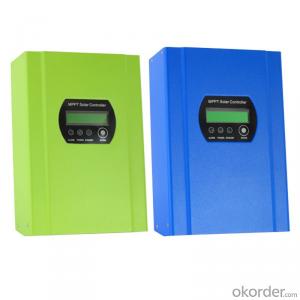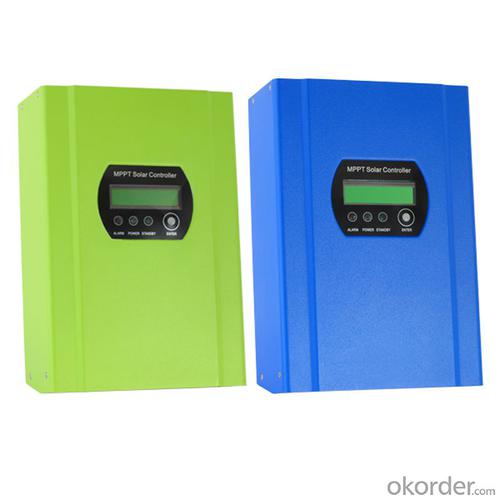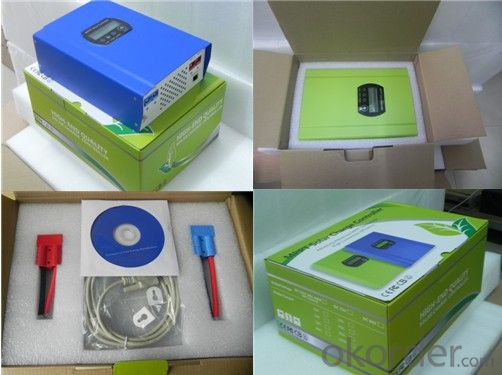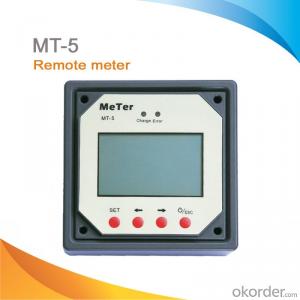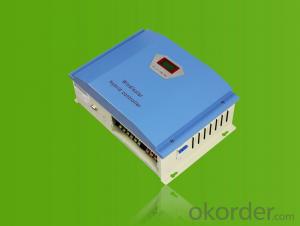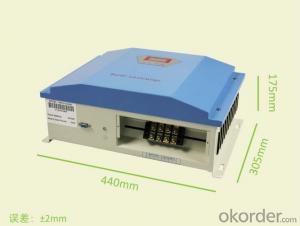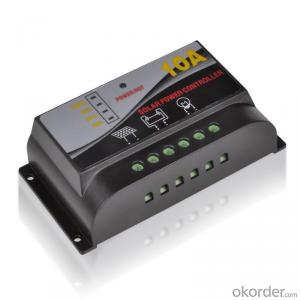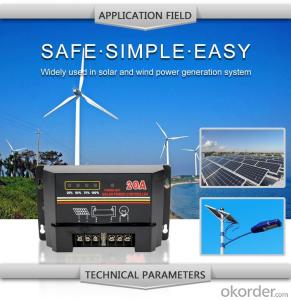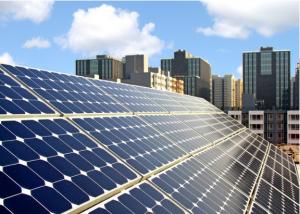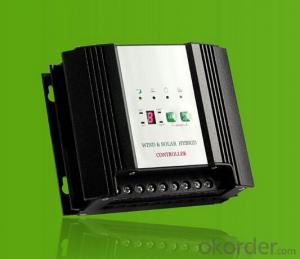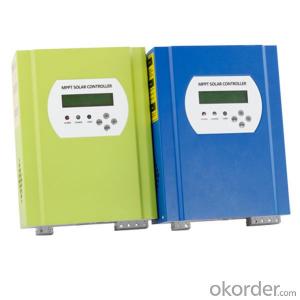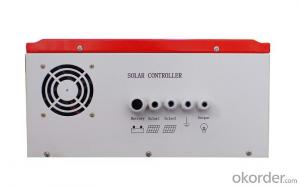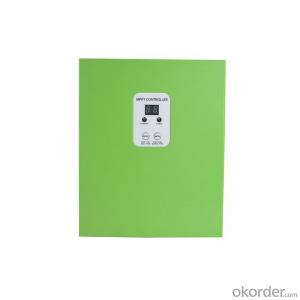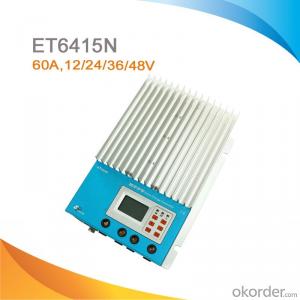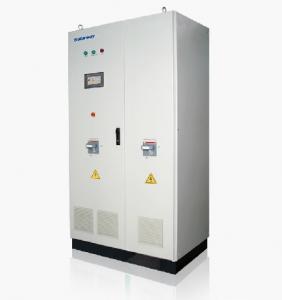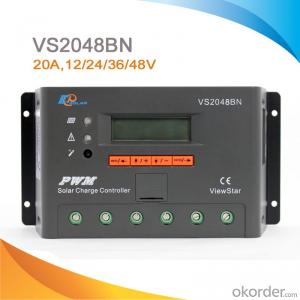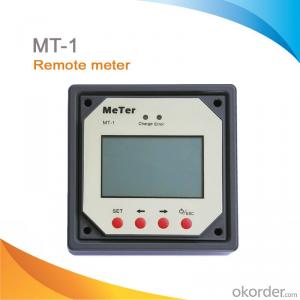Choosing Mppt Solar Controllers:Multifunctional 30A 12V 24V 48V Battery MPPT Solar Charge Controller 40A~60A
- Loading Port:
- China main port
- Payment Terms:
- TT OR LC
- Min Order Qty:
- 20 unit
- Supply Capability:
- 9999 unit/month
OKorder Service Pledge
OKorder Financial Service
You Might Also Like
solar power regulator controller,mppt charge controller 60A 12v/24v/48v mppt
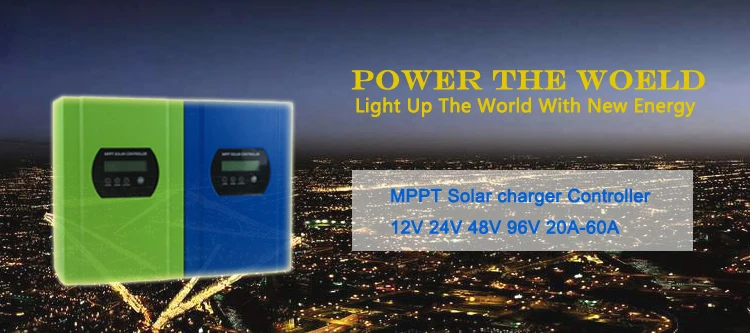
Hi, this is I-P- Smart1-DC12V/24V/48V-60A MPPT Solar Controller. With MPPT, it can target the highest output possibe from PV panels, make efficiency higher upto 30%~60% than traditional PWM ones. It can store energy to different kinds of batteries(Gel,Vented, Sealed,NiCd). More details please check the following information:
| Product Show |
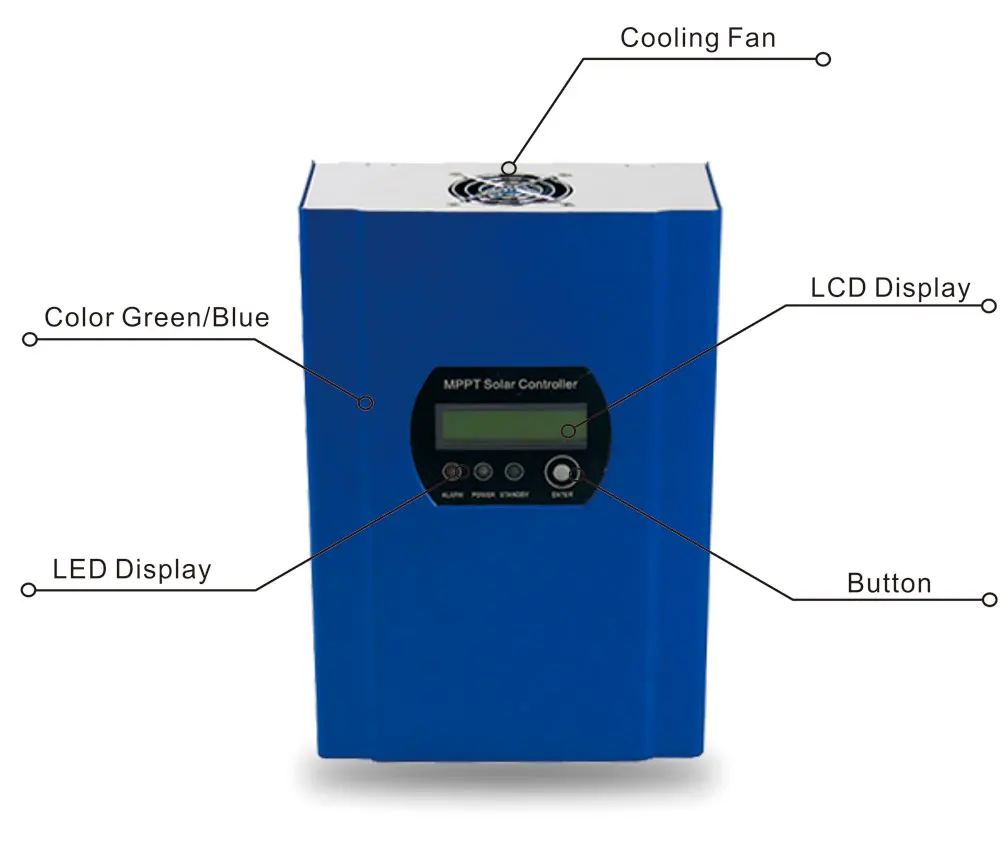
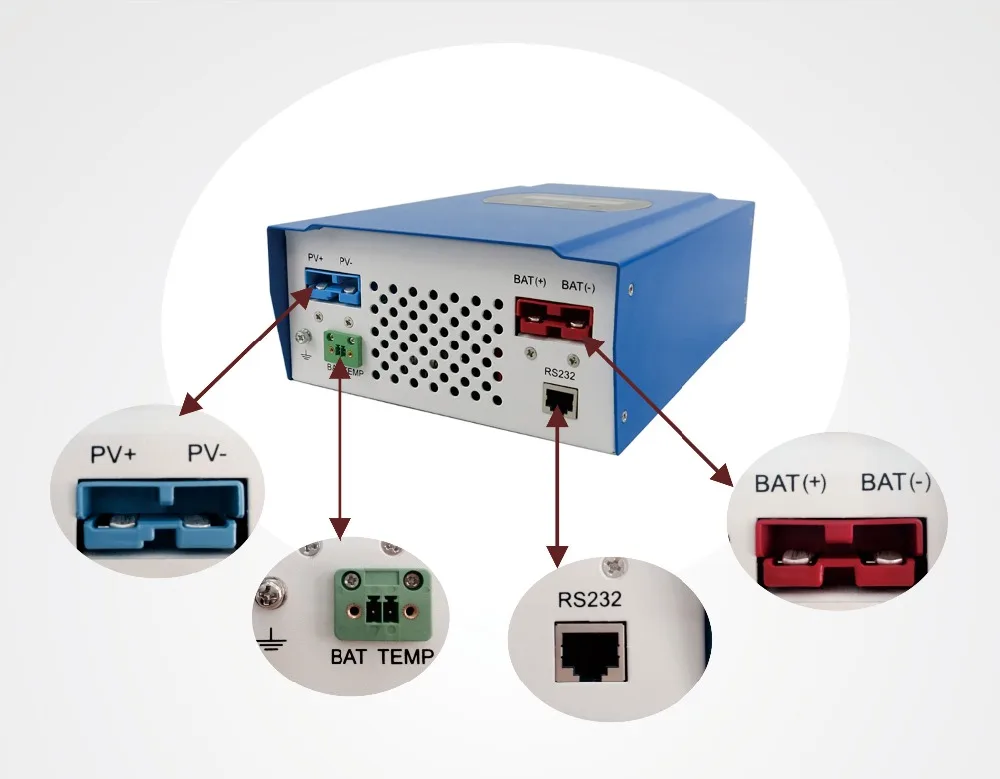
| Application |
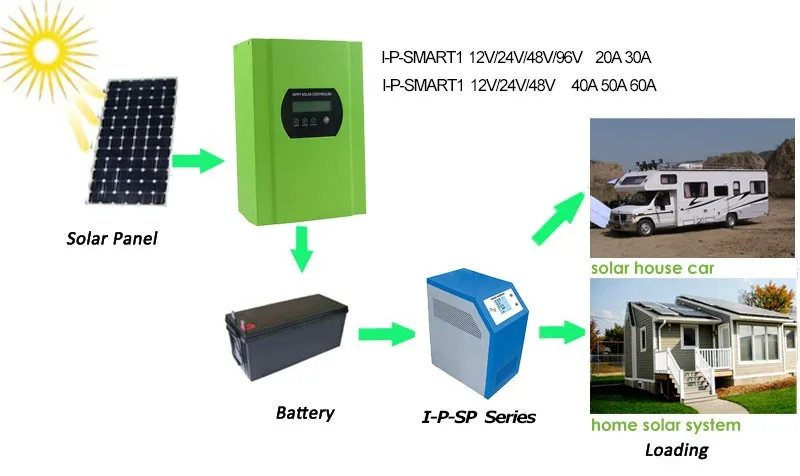
| Features |
1. Peak efficiency upto 99% with MPPT,increasing 30%~60% efficiency than traditional controller.
2. 12v/24v/48v system voltage automatic recognize.
3. Maximum input PV voltage upto DC150V.
4. 105degrees can be sufferred by good components.
5. Charge mode: three stages (fast charge, constant charge, floating charge)
6. Support kinds of batteries:Gel,Sealed lead acid,vented,NiCd,etc.
7. LCD and LED show parameters and system information,like PV input voltage,battery voltage,charge current,charge power,etc.
8. Port RS232 or connects to PC with upper software to show working state and parameters in 11 languages.
9. CE,RoHS certificatons approved.
10. 2 years warranty;3~10 years extended technical service.
RS232 Function working stat |
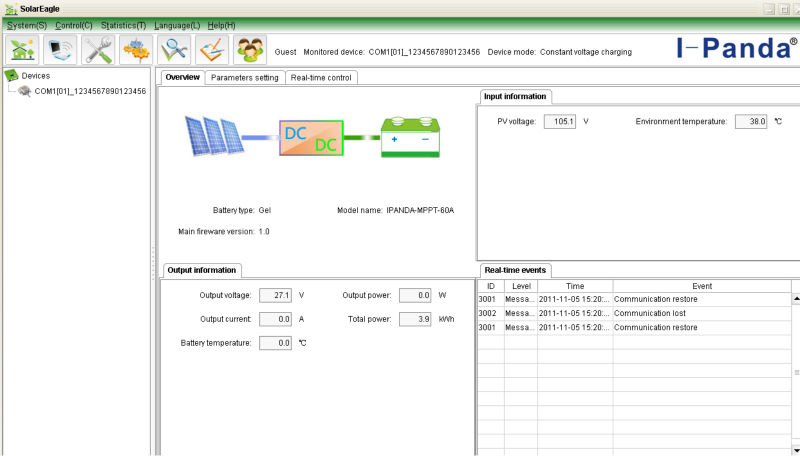
parameters |
Model:I-P-MSC-DC12V/24V/48V-series | 40A | 50A | 60A | ||||
Charge Mode | Maximum Power Point Tracking | ||||||
Method | 3 stages: fast charge(MPPT),constant voltage,floating charge | ||||||
System Type | DC12V/24V/48V | Automatic recognition | |||||
System Voltage | 12V system | DC9V~DC15V | |||||
24V system | DC18V~DC30V | ||||||
48Vsystem | DC36V~DC60V | ||||||
Soft Start Time | 12V/24V/48Vsystem | ≤10S | |||||
Dynamic Response Recovery Time | 12V/24V/48Vsystem | 500us | |||||
Conversion Efficiency | 12V/24V/48Vsystem | ≥96.5%,≤99% | |||||
PV Modules Utilization Rate | 12V/24V/48Vsystem | ≥99% | |||||
Input Characteristics | |||||||
MPPT Working Voltage and Range | 12V system | DC18V~DC150V | |||||
24V system | DC34~DC150V | ||||||
48V system | DC65~DC150V | ||||||
Low Voltage Input Protection Point | 12V system | DC16V | |||||
24V system | DC30V | ||||||
48V system | DC60V | ||||||
Low Voltage Input Recovery Point
| 12V system | DC22V | |||||
24V system | DC34V | ||||||
48V system | DC65V | ||||||
Max DC Voltage | 12V/24V/48V system | DC160V | |||||
Input Overvoltage Protection Point | 12V/24V/48V system | DC150V | |||||
Input Overvoltage Recovery Point | 12V/24V/48V system | DC145V | |||||
Max. PV Power | 12V system | 570W | 700W | 900W | |||
24V system | 1130W | 1400W | 1700W | ||||
48V system | 2270W | 2800W | 3400W | ||||
Output Characteristics | |||||||
Selectable Battery Types (Default type is GEL battery) | 12V/24V/48Vsystem | Sealed lead acid, vented, Gel, NiCd battery | |||||
Constant Voltage | 12V/24V/48V system | Please check the charge voltage according to the battery type form. | |||||
Floating Charge Voltage | 12V/24V/48V system | ||||||
Over Charge Protection Voltage | 12V system | 14.6V | |||||
24V system | 29.2V | ||||||
48V system | 58.4V | ||||||
Rated Output Current | 12V/24V/48V system | 40A | 50A | 60A | |||
Current-limiting Protection | 12V/24V/48V system | 44A | 55A | 66A | |||
Temperature Factor | 12V/24V/48V system | ±0.02%/℃ | |||||
Temperature Compensation | 12V/24V/48V system | 14.2V-(The highest temperature-25℃)*0.3 | |||||
Output Ripples(peak) | 12V/24V/48V system | 200mV | |||||
Output Voltage Stability Precision | 12V/24V/48V system | ≤±1.5% | |||||
Remark |
1. All the above parameters come from our former customers' requirements, if you have special need, we can adjust the parameter for you, such as DC voltage, charging current, etc.
2.Payment terms: 100% By T/T; 30% by T/T in advance, balance by T/T ; 100% Western Union;
3.Delivery Terms: EXWorks
4.Delivery Time: sample 1-2 working days after payment; big order depends on the quantity;
5.Providing OEM & ODM service;
Packaging & Shipping |
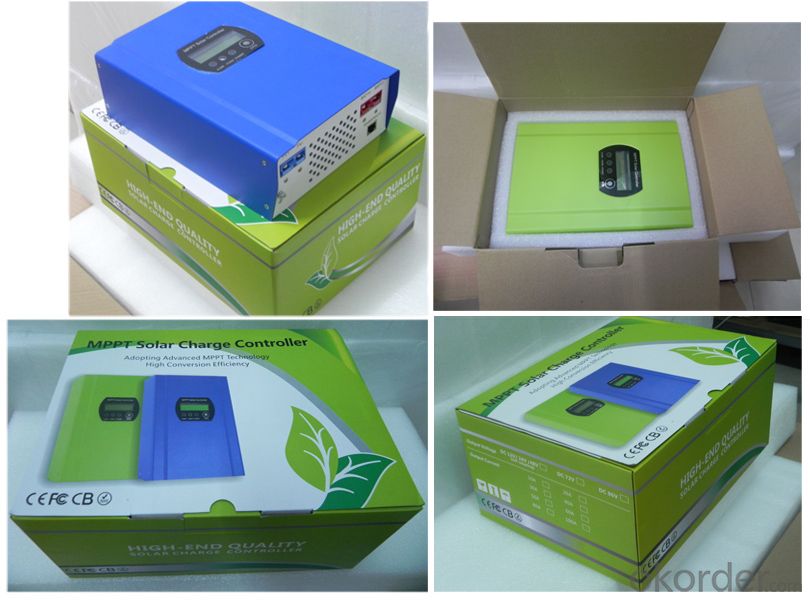
Certifications |
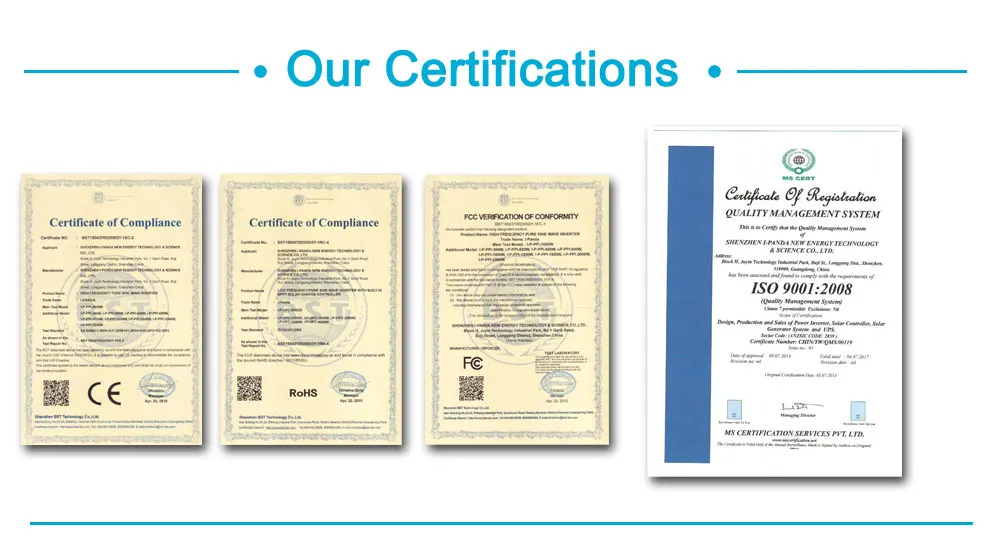
F&Q: |
Q1. How to ensure and monitor the products quality?
A1: We have established a perfect Quality Management System, In strict
accordance with ISO9001: 2008 quality system and ISO14001 environment system for quality assurance management;
Our ISO9001:2008 Quality System certificate encoding: CHIN/TW/QMS/00119;
Our ISO14001 Environment System certificate encoding: CHIN/TW/EMS/00028;
Q2. What is the warranty of products?
A2: The warranty period of different products are different; 5 years, 3 years, 2 years, 1 years; More details please refer to the product specification or manual; we will provide free life-long technical support ;
Q3. What is the difference between MPPT&PWM?
A3. MPPT charging mode, peak efficiency up to 99%, saving 30%~60% solar panel than traditional PWM controller.
- Q: How do I ensure proper grounding for a solar controller?
- To ensure proper grounding for a solar controller, you should follow these steps: 1. Locate a suitable grounding point: Find a metallic structure, such as a grounded metal rod or a metal pipe, preferably close to the solar controller installation site. 2. Clear the grounding area: Remove any dirt, paint, or rust from the chosen grounding point to ensure a good electrical connection. 3. Connect the ground wire: Use a copper conductor or a grounding cable to connect the grounding point to the ground terminal on the solar controller. Make sure the connection is tight and secure. 4. Avoid sharp bends: Ensure the ground wire is not bent sharply, as this can impede the flow of electrical current. Instead, maintain gentle curves or use grounding clamps to navigate around obstacles. 5. Protect the ground wire: Safeguard the ground wire from physical damage or exposure to moisture by using conduit or other suitable protective measures. 6. Test the grounding: After installation, use a multimeter to verify that the ground wire is properly connected and has low resistance to earth. This will ensure that the solar controller is effectively grounded. By following these steps, you can ensure proper grounding for your solar controller, which helps protect against electrical surges and improves system safety and performance.
- Q: Can a solar controller be used in a solar-powered charging station?
- Yes, a solar controller can be used in a solar-powered charging station. A solar controller is an essential component of a solar power system as it regulates the voltage and current from the solar panels to ensure efficient charging of batteries or devices. In a solar-powered charging station, a solar controller would help optimize the charging process and protect the batteries from overcharging or damage.
- Q: Can a solar controller be used with high voltage solar panels?
- Indeed, high voltage solar panels can be utilized in conjunction with a solar controller. Commonly referred to as a charge controller, a solar controller is an indispensable element within a solar power system that regulates the voltage and current flowing from the solar panels towards either the battery or grid. Typically, high voltage solar panels have the tendency to generate an output voltage that surpasses the required voltage for the battery or grid. In these instances, a solar controller becomes imperative for constraining the voltage to guarantee proper charging and power distribution. Contemporary solar controllers are engineered to accommodate a wide range of voltage levels, including those emanating from high voltage solar panels. These controllers leverage sophisticated circuitry and technology to effectively convert the high voltage output from the panels to an appropriate level for the battery or grid. To ensure seamless compatibility, it is of utmost importance to meticulously assess the specifications of the solar controller and ascertain its ability to handle the high voltage output of the panels. Furthermore, the solar controller must be adequately sized to accommodate the current capacity of the solar panels, thus preventing any potential overloading predicaments. Employing a solar controller in conjunction with high voltage solar panels plays a pivotal role in optimizing the system's performance, efficiency, and durability. It acts as a safeguard against overcharging or overloading, thereby promoting safe and reliable operation for both the battery and grid.
- Q: Can a solar controller be used with solar-powered indoor recreational facilities?
- Solar-powered indoor recreational facilities can make use of a solar controller. This component is essential in a solar power system as it regulates the flow of electricity from the solar panels to the batteries. Its main function is to ensure efficient charging of the batteries and prevent any potential damage caused by overcharging. When it comes to solar-powered indoor recreational facilities like indoor swimming pools, gyms, or entertainment centers, the solar controller plays a crucial role in managing the energy generated by the solar panels. It helps optimize energy usage, store excess energy in batteries, and guarantee a continuous power supply even in low or no sunlight conditions. By incorporating a solar controller, these indoor recreational facilities can significantly reduce their reliance on traditional grid electricity, resulting in lower energy costs and a promotion of sustainability. Additionally, it enables them to operate independently from the grid, enhancing their ability to withstand power outages or other disruptions. All in all, including a solar controller in a solar-powered indoor recreational facility is a wise and environmentally friendly choice that can lead to long-term savings and various environmental benefits.
- Q: Can a solar controller be used with a solar-powered marine navigation system?
- Yes, a solar controller can be used with a solar-powered marine navigation system. A solar controller, also known as a charge controller, is an essential component of a solar power system. It regulates the flow of electricity from the solar panels to the battery bank, ensuring optimal charging and preventing overcharging or damage to the batteries. In the case of a solar-powered marine navigation system, the solar controller plays a crucial role in managing the energy generated by the solar panels. It ensures that the batteries are charged efficiently and protects them from overcharging, which can lead to reduced battery life or even failure. By using a solar controller, the solar-powered marine navigation system can harness the energy from the sun and convert it into usable power for the navigation equipment. This allows for reliable and sustainable operation of the system, even in remote or off-grid locations where traditional power sources may be limited or unavailable. Therefore, a solar controller is not only compatible but also necessary for the proper functioning and longevity of a solar-powered marine navigation system.
- Q: Can a solar controller handle both 12V and 24V systems?
- No, a solar controller is designed to handle either a 12V or a 24V system, but not both simultaneously.
- Q: How does a solar controller handle voltage fluctuations from the solar panels?
- A solar controller handles voltage fluctuations from the solar panels by regulating and stabilizing the incoming voltage to ensure it remains within the acceptable range for the connected battery or load. It does so by constantly monitoring the voltage and adjusting the charging or discharging process accordingly, employing techniques like pulse width modulation (PWM) or maximum power point tracking (MPPT) to maximize the efficiency of energy conversion.
- Q: What is the maximum current a solar controller can handle?
- The maximum current a solar controller can handle depends on its specifications and capacity. It varies from model to model, but generally, solar controllers can handle currents ranging from a few amps to several hundred amps.
- Q: Can a solar controller be used with solar panels that have different voltages?
- No, a solar controller cannot be used with solar panels that have different voltages. The solar controller is designed to regulate and optimize the charging of the battery bank based on the voltage output of the solar panels. If the solar panels have different voltages, it can lead to inefficient charging and potential damage to the controller and batteries. It is important to match the voltage of the solar panels to ensure compatibility and proper functioning of the solar system.
- Q: Can a solar controller be used with solar-powered data centers?
- Yes, a solar controller can be used with solar-powered data centers. A solar controller is a crucial component of a solar power system that regulates the flow of electricity generated by solar panels. It ensures that the solar power system operates efficiently and effectively by managing the charging and discharging of batteries. In a solar-powered data center, a solar controller helps optimize the utilization of solar energy, enabling the data center to rely on renewable energy sources and reduce its carbon footprint.
Send your message to us
Choosing Mppt Solar Controllers:Multifunctional 30A 12V 24V 48V Battery MPPT Solar Charge Controller 40A~60A
- Loading Port:
- China main port
- Payment Terms:
- TT OR LC
- Min Order Qty:
- 20 unit
- Supply Capability:
- 9999 unit/month
OKorder Service Pledge
OKorder Financial Service
Similar products
Hot products
Hot Searches
Related keywords
